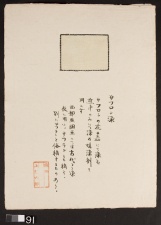Difference between revisions of "Saffron - center (91 C)"
Jump to navigation
Jump to search
(username removed) |
(username removed) |
||
| (One intermediate revision by the same user not shown) | |||
| Line 1: | Line 1: | ||
| − | {| class="wikitable" | + | [[[SliderGallery rightalign|Uemura_05-29-2009_091.jpg~Normal]]]{| class="wikitable" |
|- | |- | ||
! scope="row"|Museum number | ! scope="row"|Museum number | ||
| 91 | | 91 | ||
|- | |- | ||
| − | ! scope="row"| | + | ! scope="row"|Uemura number / title |
| − | | | + | | ; "Haze-some 25" |
|- | |- | ||
! scope="row"|Folder location | ! scope="row"|Folder location | ||
| Line 44: | Line 44: | ||
| - | | - | ||
|- | |- | ||
| − | ! scope="row"| | + | ! scope="row"|Uemura's notes |
| The plant was used for dyeing fabrics in the West Asia since the ancient time. | | The plant was used for dyeing fabrics in the West Asia since the ancient time. | ||
|- | |- | ||
| − | ! scope="row"| | + | ! scope="row"|Uemura's date |
| Kyoto | | Kyoto | ||
|} | |} | ||
| − | [[Category: | + | [[Category:Uemura dye archive]] |
Latest revision as of 06:17, 24 July 2013
| Museum number | 91 |
|---|---|
| Uemura number / title | ; "Haze-some 25" |
| Folder location | 2nd shelf |
| Sample location | center (91 C) |
| Fiber type | cotton |
| Color | cream |
| Dyestuff (Japanese common name) | サフロン : Saffron |
| Dye (English common name) | Saffron |
| Dyestuff (botanical name) | Crocus sativus L. |
| Plant part | pistil /dried |
| Dyestuff extraction | boiled in water |
| Auxiliary agent in dye bath | - |
| Mordant | - |
| Other auxiliary agent | - |
| Uemura's notes | The plant was used for dyeing fabrics in the West Asia since the ancient time. |
| Uemura's date | Kyoto |
